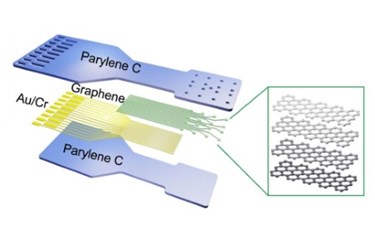Graphene Sensors Stimulate Neurons Optically And Electronically
By Chuck Seegert, Ph.D.

While electrical sensing is a mainstay of neurological studies, optical methods have recently started to become more prevalent. A new sensor system from DARPA now allows both modalities to be used together, for greater insights into neural structure and function.
Electrical impulses are the primary way that neural cells communicate. Historically, electrical studies have enabled the evaluation of neural cell communication. Generally, the understanding of neural cells that was gained by studying electrical impulses was garnered through correlation studies, so a direct link was not possible to prove relationships between neural cell electrical activity and behavior.
Recently, the development of optogenetics has allowed optical studies by inducing cells to produce fluorescent proteins. These proteins are indicators of behavior and, if they could be studied simultaneously with electrical stimulation, it would provide the direct link that was previously missing. Now, a new graphene sensor from DARPA-funded researcher could make this possible, according to a recent press release from DARPA.
“This technology demonstrates potentially breakthrough capabilities for visualizing and quantifying neural network activity in the brain,” said Doug Weber, DARPA program manager, in the press release. “The ability to simultaneously measure electrical activity on a large and fast scale with direct visualization and modulation of neuronal network anatomy could provide unprecedented insight into relationships between brain structure and function—and importantly, how these relationships evolve over time or are perturbed by injury or disease.”
The sensor system is based on graphene, with layers of the conductive material that are only about four atoms thick. This makes the material optically transparent, and when combined with a plastic backing layer, allows the study of the optogenetic responses of cells, according to the press release. The sensors are also capable of electrically stimulating the tissue.
Optical transparency of the device is very high, allowing greater than 90 percent transmission over the infrared and ultraviolet spectrum, according to an article published by the research team in Nature Communications. The transparency allows optical studies to be measured directly under the electrodes using fluorescence microscopy and optical coherence tomography.
Graphene has taken off recently in the medical device space for many applications. One of the most common applications is biosensing of cancer biomarkers and DNA. Some observers even wonder if graphene is the next frontier in medical diagnostics.
